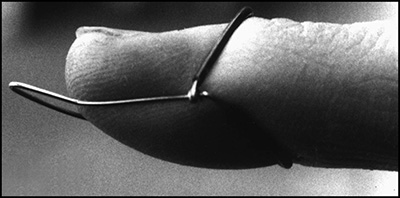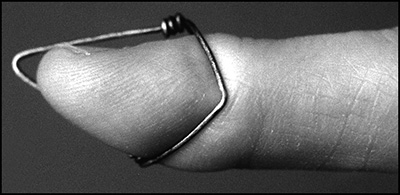The three tala strings are drone strings and are plucked upward with the little finger of the right hand. This plucking is called kanistika meettu in theoretical treatises. Usually the nail of the little finger is used to execute this plucking motion but some musicians use a little metallic plectrum, which is similar in shape to those used in the west to play the guitar.
We come across three types of plucking motions depending on the styles and the musical requirements: 1) The simultaneous attack of the three strings in a “block chord”, 2) plucking of the same strings slowly, one after the other, in a “broken chord” and finally 3) the selective plucking of only one of the three strings. Furthermore the kanistika meettu can be executed alone or together with the plucking of a melodic string with the index or the middle finger.
The tala strings owe their name to the fact that their primary purpose is to be plucked, generally together, based on the strong beats of the rhythmic cycles, marking its smooth flow. These strong beats are the first beats of the laghus, drutams or the anudrutam. In Adi tala this corresponds to the first, fifth and the seventh beats. This is a widespread practice not specific to any particular school. However, how strictly the marking of the beats is maintained throughout the piece varies from one artist to another. The tala strings owe their name to the fact that their primary purpose is to be plucked, generally together, based on the strong beats of the rhythmic cycles, marking its smooth flow. These strong beats are the first beats of the laghus, drutams or the anudrutam. In Adi tala this corresponds to the first, fifth and the seventh beats. This is a widespread practice not specific to any particular school. However, how strictly the marking of the beats is maintained throughout the piece varies from one artist to another.
The other functions of the tala strings in the alapana sections are to act as punctuation or even a drone. It is mainly in this improvised form that the wide range of plucking styles (block chords, broken chords or single string stroke) and uses is evident. Some schools hardly ever use these strings during the alapana, others use them very subtly between the melodic phrases and yet others use them at all times.
These strings are of great significance for the execution of the tanams. It is undoubtedly their presence that enables the veena to be the privileged means to interpret this form. They can then be plucked simultaneously or alternating with the melodic strings.
Thus the set of tala strings has three functions – punctuation, drone or maintenance of the rhythmic beat, but it is rarely used to produce the melody. Therefore its relation with the voice may seem to be less. However it includes the two actions that every singer carries out constantly with each of his two hands – regular marking of the tala and the slow plucking of the tampura strings.
|
 Position of the plectrum to play the veena
Position of the plectrum to play the veena Position of the plectrum to play the sitar
Position of the plectrum to play the sitar Position of the plectrum to play the veena
Position of the plectrum to play the veena Position of the plectrum to play the sitar
Position of the plectrum to play the sitar